Very few of us have room for plants that don’t perform in our gardens, so we want the crème de la crème, plants that not only look lovely but flourish for a long time. We want them to return year after year and be good neighbours, ones that won’t muscle in on other things. With this in mind, it always helps to look for an AGM award, as this is a reliable indicator of a great plant.
Planting tips
When it comes to choosing plants we need to learn to love colour, because the days of the pastel English country garden that looks like a watercolour painting have largely gone. Also, try to avoid planting only one of each thing as this will resemble a pincushion of dots. Far better to plant in threes, fives or sevens, always odd numbers, and avoid forming cloud-like blobs. Make a triangular shape, or a narrow ribbon that looks like its waving in the wind. This is much more pleasing on the eye.
Sunset Shades
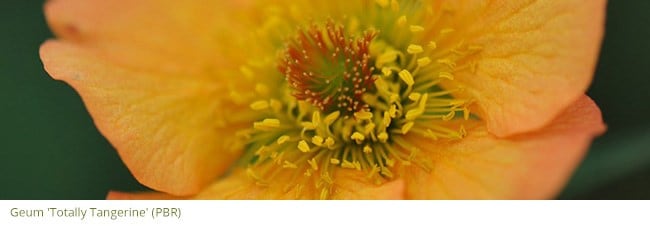
Embrace orange and warm peachy shades because they make blue and purple more vibrant, especially in evening light. Begin by finding room for a tall geum called ‘Totally Tangerine’, a recently bred plant but already among the top rank. This will begin to flower in April, putting up tall wiry stems capable of weaving through other plants, and it will still be going in November because it’s a sterile hybrid incapable of setting seed. The colour is far from tangerine, more of a soft pumpkin orange with pale apricot, so this dainty geum casts a subtle spell like tiny fairy lights in a border. These pinpricks of warm colour could mingle with the slate-blue starry flowers of Amsonia tabernaemontana var. salicifolia, or arrange themselves over and among the slender copper-orange leaves of the sedge Carex testacea. Grasses always add movement and some give a year-long presence. They also unify a scheme when woven through a mixed border.
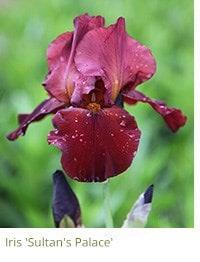
A brighter shade of orange can be had from another long-flowering geum called ‘Prinses Juliana’. This shorter geum, with semi-double flowers on foot-high stems, gives a fourteen week display beginning in late May or June. Find a front of the border position and do plant a drift, for bright showy colours need to be woven through a border to avoid looking like a blot on the landscape. Use Stipa tenuissima, the pale green ponytail grass that resembles a fine optic lamp, or irises such as the mulberry petalled Iris ‘Sultan's Palace'. This may sound a strange colour combination, but bearded irises often have orange beards on their falls, so the two will marry together easily. Learn to look for minute detail when blending flowers!
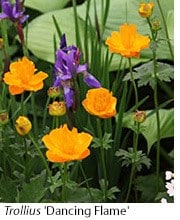 Equally bright, although in need of fertile, moisture-retentive soil, is Trollius chinensis ‘Dancing Flame’, an award-winning globe flower that rises upwards in early May. It’s very vigorous and upright, with vivid orange flowers that open to expose a punk haircut of slender orange stamenoids - the posh word for stamens that have evolved into petals. The buds are held in green-stained sepals and the buttercup-like foliage is also a bright green and it has an arts and crafts style to it. It’s easy in good soil.
Equally bright, although in need of fertile, moisture-retentive soil, is Trollius chinensis ‘Dancing Flame’, an award-winning globe flower that rises upwards in early May. It’s very vigorous and upright, with vivid orange flowers that open to expose a punk haircut of slender orange stamenoids - the posh word for stamens that have evolved into petals. The buds are held in green-stained sepals and the buttercup-like foliage is also a bright green and it has an arts and crafts style to it. It’s easy in good soil.
American bred hybrid peonies come in volatile shades of hot-pink, coral and tangerine and their flowers change as they mature so an established plant will resemble an ice cream sundae as more flowers open. ‘Coral Sunset’, which is also good with blues including amsonia, is a shorter peony with semi-double, orange-pink flowers that form shallow saucers. The gently curved petals frame a boss of bee-friendly stamens and seeds sometimes follow, although they will not produce identical plants so you may wish to deadhead. Once established, you’ll get a dozen flowers in hot-coral, softening to apricot and cream over a week or two.
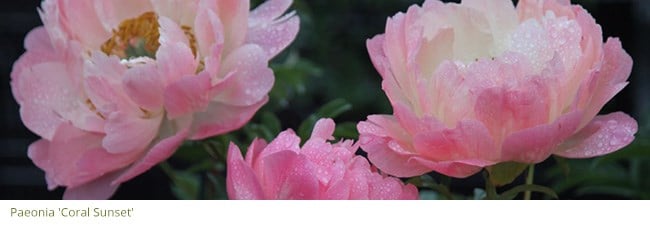
American bred peonies evolved in the Continental climate of the central parts of the United States so hardiness is not a problem for them. In fact they need cold winter days to initiate flower buds and for this reason the tuberous roots have to be a mere two inches below the soil. However they also enjoy warmth so place them in a sheltered position. They can do very well on the sunny side of a brick wall. Given this, they get much taller. Should you cut one or two, if you can ever bare to, their flowers will fade even more dramatically.
Evening Stars
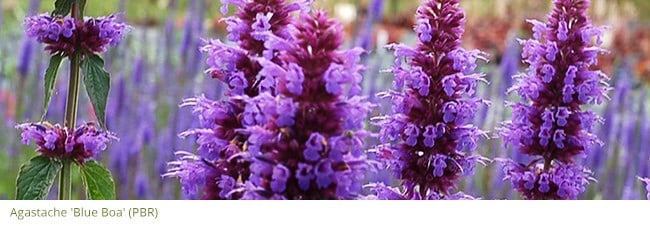
Blue is a touch-paper colour if used with orange and yellow and it stands out in dusk like the evening star. However it’s a rare phenomenon in garden plants, so you have to work at adding an infusion. Good blues, with a long flowering season, include Agastache. These aromatic plants have blue flowers that vary from the slender black-stemmed, violet-flowered ‘Blackadder’, to the softer-hued bottle brushes of ‘Blue Fortune’. A new, shorter agastache called ‘Blue Boa’ combines pink-lavender flowers emerging from a maroon-red spike. Useful plants, which survive well in reasonably drained soil, they provide upright verticals in strong blue, black and violet. Cut them down in spring in colder districts and try to find well-drained places.
 Veronicas (the herbaceous ones), were a garden staple before they were upstaged by taller, later-flowering veronicastrums planted in the Piet Oudolf style. However there are some new veronicas and they include V. spicata ‘Royal Candles’ a vibrant foot-high perennial with bright green foliage and bright blue flowers. The tapering candles combine deep blue and bright green, a summer-fresh combination and, when deadheaded, more flowers appear. Use close to roses with either yellow, orange or deep pink flowers, because the two will overlap and flatter each other.
Veronicas (the herbaceous ones), were a garden staple before they were upstaged by taller, later-flowering veronicastrums planted in the Piet Oudolf style. However there are some new veronicas and they include V. spicata ‘Royal Candles’ a vibrant foot-high perennial with bright green foliage and bright blue flowers. The tapering candles combine deep blue and bright green, a summer-fresh combination and, when deadheaded, more flowers appear. Use close to roses with either yellow, orange or deep pink flowers, because the two will overlap and flatter each other.
Blue and violet-blue look tremendous in a woodland setting especially situated close to the spring-flowering mound of Euphorbia epithymoides (once E. polychroma). It’s the earliest of the deciduous spurges to perform and, in order to make it truly perennial, it should be cut back after flowering so that it produces new growth at the base. Care always needs to be taken when cutting back euphorbias because their latex-like sap is an irritant to the skin and it can damage your eyes in severe cases.
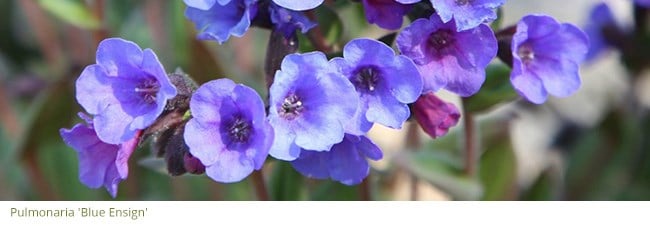
The acid yellow bracts of E. epithymoides last for many weeks and it’s biddable enough to flower in some shade. Team it with the deep blue, green-leaved Pulmonaria ‘Blue Ensign’. This doesn’t appear to set seed (as so many pulmonarias do) and it’s interesting from the moment it leaves the ground, with purple shoots that thrust through the soil like space rockets. The flowers are almost gentian-blue in intensity. For intense violet flowers opt for Pulmonaria 'Trevi Fountain' and you’ll also get silver-spotted foliage as well. Both are in the top rank of pulmonarias and deserve a place in every garden.
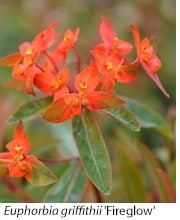 Later in the year lots of deciduous euphorbias will provide a cloud of acid-yellow and among the best is E. palustris, a June performer that enjoys good soil. 'Walenburg's Glorie' is a selected brighter yellow form. Or you might prefer the fiery orange bracts and foliage of E.griffithii ‘Fireglow’, a plant that creeps a little maybe, but is enormously useful in dank corners of the garden where nothing much flourishes. The asparagus-like spears of fiery apricot-orange pierce the earth in mid-spring and flowers follow in May, often coinciding with late tulips.
Later in the year lots of deciduous euphorbias will provide a cloud of acid-yellow and among the best is E. palustris, a June performer that enjoys good soil. 'Walenburg's Glorie' is a selected brighter yellow form. Or you might prefer the fiery orange bracts and foliage of E.griffithii ‘Fireglow’, a plant that creeps a little maybe, but is enormously useful in dank corners of the garden where nothing much flourishes. The asparagus-like spears of fiery apricot-orange pierce the earth in mid-spring and flowers follow in May, often coinciding with late tulips.
Bright splashes of gold are useful in dank corners, but they can look sickly in bright light. Dark foliage, on the other hand, shines in sunlight and sets off flowers of any colour. Hylotelephium telephium 'Purple Emperor' should be at the top of everyone’s ‘dark, dusky and interesting’ wish list because the neat foliage is dark from the word go: other sedums take their time to colour and darken. The neatly crimped foliage, which is smoky and plump, stays pristine and this foot-high plant doesn’t split at the crown so it can stay undivided for many years. The deep pink flowers shine in August, earlier than many sedums, and they are bee-friendly. And not all sedums are!
Day's Eyes - for open sun
Equally insect friendly are the daisy family with their long-lasting ray florets surrounding a hub of tiny flowers. Staple daisies include the September-flowering lavender-blue aster now named Symphyotrichum 'Little Carlow'. It’s replaced aster, which was easier to spell, although that never bothers a botanist! This is a metre-high bushy aster that’s usually self-supporting and it has small lavender-blue flowers with a hint of red in the middle. In September light it glows like a Bunsen burner and should be planted in every garden. I particularly love the glint of red in the intricately-feathered buds in August.
 Anthemis ‘E.C. Buxton’ is a golden oldie that’s been around for decades, but it can’t be beaten for flower power because this summer performer produces clear yellow daisies on strong green stems above dark green filigree foliage. The flowers last for weeks, a trait with daisies, and this sun-lover can be drifted through with deep blue eryngiums such as Eryngium × zabelii 'Jos Eijking' or used with rusty achilleas such as Achillea 'Walther Funcke'. All three will come through winter reliably well, although anthemis need regular propagation every two years or so. Just pluck young growth, about five inches in length (12cm) away in early summer and you’ll get pieces with root already attached. These root easily in a pot. Or you could try the new golden-leaved Eryngium ‘Neptune’s Gold’.
Anthemis ‘E.C. Buxton’ is a golden oldie that’s been around for decades, but it can’t be beaten for flower power because this summer performer produces clear yellow daisies on strong green stems above dark green filigree foliage. The flowers last for weeks, a trait with daisies, and this sun-lover can be drifted through with deep blue eryngiums such as Eryngium × zabelii 'Jos Eijking' or used with rusty achilleas such as Achillea 'Walther Funcke'. All three will come through winter reliably well, although anthemis need regular propagation every two years or so. Just pluck young growth, about five inches in length (12cm) away in early summer and you’ll get pieces with root already attached. These root easily in a pot. Or you could try the new golden-leaved Eryngium ‘Neptune’s Gold’.













